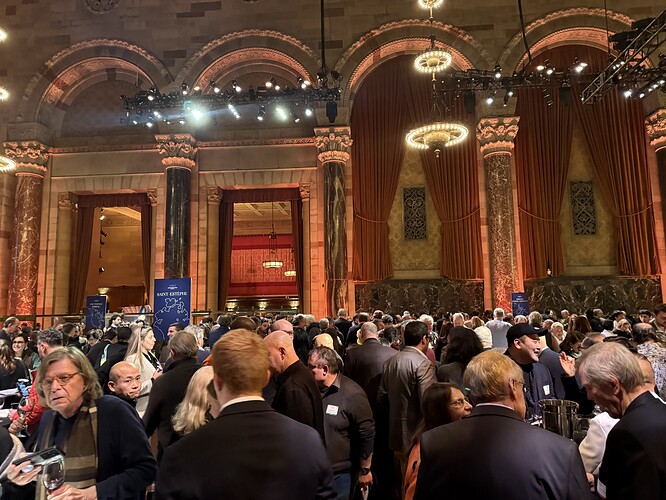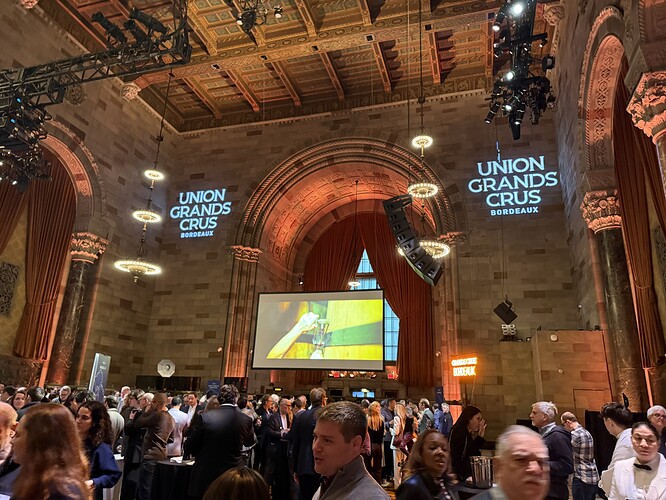Marc - Someone told me that you were there, but I did not see you. Here is my report, which I wroote up just for fun and then saw yours.
My 2022 Bordeaux Report
You might logically ask, “why are you so arrogant as to write up a report on the 2022 Bordeaux vintage?” That’s a fair question because my entrée into the wine media, and hence my attendance at the trade posrtion of the event, is only as the founding editor-in-chief of the “Alcohol Law Newsletter,” which has much more to do with law than wine.
However, I have often said that the best wine is the wine that you like the most. Add that I have been drinking French wine since that fateful day in 1967 when they gave me, at age 15, a quarter bottle of 1966 Beaujolais in my box lunch on the train from Lucerne to Paris. So I decided to write up my impressions of the 2022 Bordeaux vintage based upon too many hours of drinking wine at the Union des Grand Cru de Bordeaux tastings in New York City. You can ignore my opinions if you want, because you are entitled to be wrong.
The Union des Grand Cru de Bordeaux is, loosely speaking, a trade association of Bordeaux producers that, as all good trade associations do, promotes the products of its members. Although not every Bordeaux producer is a member, there are more than enough that you either spit while tasting or can’t possibly make your way through the entire lineup. Take very small pours and spit a lot and you will still be unable to try everything. I didn’t come close, but I came away with the general impression, shared by much of the industry, that the 2022 Bordeaux vintage is excellent. Very few disappointments and, in most cases, the wines at the low end of the scale were still very good.
For those with knowledge of the past, this may be the opposite of the historically horrible years, like 1968 and 2002. Being in 1951 baby myself, another horrible year, I know the feeling of having to settle for Colheita Port and Rivesaltas. If you have children or grandchildren born in 2022, stock up.
One other comment before I get to the wines themselves. Most of the wines are poured by owners, winemakers, export managers and their assistants. Although they are all very positive about their wines, and everyone knows that every Bordelais believes that “this year” is the year of the century, there is a lot to be learned by talking to them. If you have the opportunity, ask about why their wine is different from other wines, what makes up their flavor profile, what vinification process they use, and anything else you want to know.
However, don’t ask them about how their wines compare to similar blends in California. They are very (!) insular. Finding someone who frequently drinks wines from Burgundy is rare. Finding someone who knows the difference between Screaming Eagle and Josh is impossible. When you mention MacDonald, they ask whether the hamburger chain sells wine. No, I am not joking. I received that response twice during the event.
Now to the specific wines.
My Stars
Clos Fourtet. Outstanding. One of my top five. Extremely plush with a smooth, velvety mouth feel. Extremely drinkable today, with its high percentage of Merlot. 90% Merlot, 7% Cabernet Franc and 3% Cabernet Sauvignon. The Merlot gives it a red fruit presentation with cherry and plum. The Cabernet Franc gives it a slight meaty, earthy component for complexity. The Cabernet Sauvignon adds a bit of tannin, but it is virtually impossible to notice against the plushness of the merlot.
I had an interesting discussion with the representative of the vineyard, who could have been the owner or the winemaker. I forgot to write it down. She was attempting to explain to the relative neophyte guy I was tasting with, politely s the French winemakers sometimes do, what makes merlot different from Cabernet Sauvignon. After she finished, I explained in blunt New York terminology to the guy, who was born in the Bronx, “Merlot is just slutty, sexy and velvety.” She laughed.
Pichon Baron. Also one of my top 5. We always want to compare Pichon Baron with Pichon Comtesse. The Comtesse is currently very tight, bordering on undrinkable. The Baron, on the other hand, is delicious now. Maybe it will shut down, maybe it won’t last for 40 years, maybe, maybe, maybe. However, I am 73 years old. The Comtesse may be an outstanding, exceptional wine, but not before my palate has rolled over and died. Unless and until the Baron shuts down, it gets my vote. I asked a lot of others about this issue and all but one had the same impression.
It appears to be a matter of winemaking and terroir. The Baron is 81% Cabernet Sauvignon while the Comtesse is 78%. Not a big difference, but the tannins in the Comtesse are fierce and in the Baron are much less so. It makes me wonder whether this could be a replay of 1975, when the reviewers went gaga over the wines with their fierce tannin, only to discover years later that the fruit disappeared before the tannins resolved.
As to flavor, the Baron was a complex mélange of fruit and spice, with an exquisite floral and fruit nose. There was a melon component on the nose, which was surprising and seemed unusual for a red wine. However, and this is a brief drift, there were a few people at the event who didn’t understand that you cannot dump an entire bottle of perfume on your head before going to a wine tasting. A number of times, I had to walk away with my glass and taste it in the corner because I was being assaulted by aromas that had nothing to do with the wine being poured. Perhaps that is where the melon component came from in the Baron, but I don’t think so.
Leoville Barton and Langoa Barton. First, a brief note about Anthony Barton, who passed away almost exactly 3 years ago. His daughter was pouring for Leoville Barton, and we briefly chatted about him. I had met him in 2007 at Café Boulud Palm Beach. He and I think M. Cazes from Lynch Bages had a mini-presentation of the 2005 vintages that I stumbled over on my one free day between a bankers’ convention and a lawyers’ convention. M. Barton was one of the more gregarious, engaging and funny winery owners I have met. An entire restaurant full of enthusiasts were enthralled with his banter and allowed us all to play a game I refer to as “Stump the Stars” with our questions. It was nice to be able to pass on the positive feeling to his daughter, especially because it was one day after the anniversary of his death.
And now, the wines. I remember being very impressed with the 2005 Langoa Barton when I had it in 2007. The same was true here. It may not be the greatest wine in St. Julien, and I have never had it with some age on it, but it was very pleasant with a fruity nose that matched the palate. White fruit in a red wine? Yes, I got a little bit of pear in this! Reasonably smooth without fierce tannins.
The Leoville Barton is a 20+ year wine that, compared to the Comtesse I discussed above, is currently drinkable. Not surprising that Cabernet Sauvignon is north of 80% of the blend. You can just feel the fruit flavors waiting to burst out from the constraints of the tannic backbone. The tannin is fierce but not bitter. Spice and pencil shavings as well. Although it has a long way to go, it is taste worthy today. I have a few bottles of the 2003. The 2022 makes me want to open one of the 2003s soon with great anticipation.
Leoville Poyferre. I missed this in the early session and did not have it until my palate was suffering from overwork, but it was excellent. Smooth and easily drinkable. Perhaps the sluttiest (see discussion of Clos Fourtet) of the wines from St. Julien that I tasted. Red fruit dominant with a vanilla component from its oak barrels. It may not last as long as the Leoville Barton, but the difference between 25 years and 50 years is not really relevant. This is definitely a buy.
The Dry White Bordeaux Contingent. Smith Haut Lafitte, Domain de Chevalier, Pape Clement, Malartic Lagraviere, Latour Martillac. Across the board, this was the most impressive group. All excellent. I have heard people at wine dinners many times, after tasting dry white Bordeaux blinds, say upon reveal, “I have to stop drinking dry white Bordeaux” or “now I know why I don’t like this.” Not the 2022s!
I had my last bottle of 1995 Smith Haut Lafitte Blanc this summer at the annual Westchester wine collectors’ dinner. It was wonderful. I can’t tell whether these wines will hold their fruit for almost 30 years, but they deliver a lot of pleasure today. Tropical fruits like guava and pineapple with melons and white fruit. Reasonably balanced acidity so they are not flabby. Gorgeous noses. It’s hard to pick between them. I think I would give the nod to Pape Clement, but it is a close call. You may not like the taste profile and the style, but I strongly suggest that you try one of these to see if it is to your liking. Not a creamy, oaky white to be sure. You would not mistake this for Chardonnay.
Suduiraut. IMNSHO, the class of the wines presented, although there was no Yquem. Other people may have preferred the La Tour Blanche, but the spiciness and sharp acidity of the Suduiraut were the deciding factor for me. Lots of white fruit and tropical fruit, with honey and pineapple. Some people claim that botrytis does not have a flavor. I think they are wrong, and the Suduiraut has it along with bracing acidity to match against the sweetness and the fruit backbone.
When I first had the 2001 Suduiraut, in approximately 2006, I thought it was underrated and bought about eight bottles at a bargain price. As time passed, The Wine Advocate increased its rating to approach the perfection of the 2001 Yquem, so I think I was right. The 2022 is reminiscent of the 2001. It is currently available in the $70 range. A bit less if you search for it.
My Second Tier
Do not say that these wines were second-rate. They were not as good, to me, as the wines I identified above, but they were still outstanding.
Cantenac Brown. This was good enough that they ran out of it during the trade portion in of the event in the afternoon, but when I returned in the evening, they had their second allocation. Very nice, classic Bordeaux without the saddle leather and corral floor.
Carmes Haut Brion. I had missed his by accident in the early session but after recommendations from a number of others, I tasted it at the evening session and despite palate fatigue it, it was quite good. Another classic Bordeaux with a currently drinkable presentation.
More later, including a lot of wines in group two, but I have some real work to do. Suffice it to say that there were some value wines that are worth pursuing (D’Armaillac and Cantemerle immediately come to mind), some surprises (Rouget, made by someone will Burgundian roots who used 30% whole cluster fermentation) and many others worth thinking about. A few disappointments, but only because my expectations for specific houses (Valandraud and Gruaud Larose) were probably too high.

